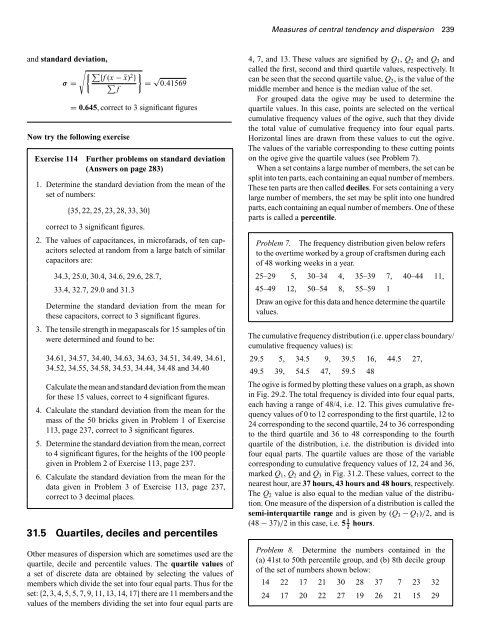basic_engineering_mathematics0
Create successful ePaper yourself
Turn your PDF publications into a flip-book with our unique Google optimized e-Paper software.
Measures of central tendency and dispersion 239<br />
and standard deviation,<br />
√ { ∑{f } (x −¯x)2 }<br />
σ = ∑ = √ 0.41569<br />
f<br />
= 0.645, correct to 3 significant figures<br />
Now try the following exercise<br />
Exercise 114<br />
Further problems on standard deviation<br />
(Answers on page 283)<br />
1. Determine the standard deviation from the mean of the<br />
set of numbers:<br />
{35, 22, 25, 23, 28, 33, 30}<br />
correct to 3 significant figures.<br />
2. The values of capacitances, in microfarads, of ten capacitors<br />
selected at random from a large batch of similar<br />
capacitors are:<br />
34.3, 25.0, 30.4, 34.6, 29.6, 28.7,<br />
33.4, 32.7, 29.0 and 31.3<br />
Determine the standard deviation from the mean for<br />
these capacitors, correct to 3 significant figures.<br />
3. The tensile strength in megapascals for 15 samples of tin<br />
were determined and found to be:<br />
34.61, 34.57, 34.40, 34.63, 34.63, 34.51, 34.49, 34.61,<br />
34.52, 34.55, 34.58, 34.53, 34.44, 34.48 and 34.40<br />
Calculate the mean and standard deviation from the mean<br />
for these 15 values, correct to 4 significant figures.<br />
4. Calculate the standard deviation from the mean for the<br />
mass of the 50 bricks given in Problem 1 of Exercise<br />
113, page 237, correct to 3 significant figures.<br />
5. Determine the standard deviation from the mean, correct<br />
to 4 significant figures, for the heights of the 100 people<br />
given in Problem 2 of Exercise 113, page 237.<br />
6. Calculate the standard deviation from the mean for the<br />
data given in Problem 3 of Exercise 113, page 237,<br />
correct to 3 decimal places.<br />
31.5 Quartiles, deciles and percentiles<br />
Other measures of dispersion which are sometimes used are the<br />
quartile, decile and percentile values. The quartile values of<br />
a set of discrete data are obtained by selecting the values of<br />
members which divide the set into four equal parts. Thus for the<br />
set: {2, 3, 4, 5, 5, 7, 9, 11, 13, 14, 17} there are 11 members and the<br />
values of the members dividing the set into four equal parts are<br />
4, 7, and 13. These values are signified by Q 1 , Q 2 and Q 3 and<br />
called the first, second and third quartile values, respectively. It<br />
can be seen that the second quartile value, Q 2 , is the value of the<br />
middle member and hence is the median value of the set.<br />
For grouped data the ogive may be used to determine the<br />
quartile values. In this case, points are selected on the vertical<br />
cumulative frequency values of the ogive, such that they divide<br />
the total value of cumulative frequency into four equal parts.<br />
Horizontal lines are drawn from these values to cut the ogive.<br />
The values of the variable corresponding to these cutting points<br />
on the ogive give the quartile values (see Problem 7).<br />
When a set contains a large number of members, the set can be<br />
split into ten parts, each containing an equal number of members.<br />
These ten parts are then called deciles. For sets containing a very<br />
large number of members, the set may be split into one hundred<br />
parts, each containing an equal number of members. One of these<br />
parts is called a percentile.<br />
Problem 7. The frequency distribution given below refers<br />
to the overtime worked by a group of craftsmen during each<br />
of 48 working weeks in a year.<br />
25–29 5, 30–34 4, 35–39 7, 40–44 11,<br />
45–49 12, 50–54 8, 55–59 1<br />
Draw an ogive for this data and hence determine the quartile<br />
values.<br />
The cumulative frequency distribution (i.e. upper class boundary/<br />
cumulative frequency values) is:<br />
29.5 5, 34.5 9, 39.5 16, 44.5 27,<br />
49.5 39, 54.5 47, 59.5 48<br />
The ogive is formed by plotting these values on a graph, as shown<br />
in Fig. 29.2. The total frequency is divided into four equal parts,<br />
each having a range of 48/4, i.e. 12. This gives cumulative frequency<br />
values of 0 to 12 corresponding to the first quartile, 12 to<br />
24 corresponding to the second quartile, 24 to 36 corresponding<br />
to the third quartile and 36 to 48 corresponding to the fourth<br />
quartile of the distribution, i.e. the distribution is divided into<br />
four equal parts. The quartile values are those of the variable<br />
corresponding to cumulative frequency values of 12, 24 and 36,<br />
marked Q 1 , Q 2 and Q 3 in Fig. 31.2. These values, correct to the<br />
nearest hour, are 37 hours, 43 hours and 48 hours, respectively.<br />
The Q 2 value is also equal to the median value of the distribution.<br />
One measure of the dispersion of a distribution is called the<br />
semi-interquartile range and is given by (Q 3 − Q 1 )/2, and is<br />
(48 − 37)/2 in this case, i.e. 5 1 2 hours.<br />
Problem 8. Determine the numbers contained in the<br />
(a) 41st to 50th percentile group, and (b) 8th decile group<br />
of the set of numbers shown below:<br />
14 22 17 21 30 28 37 7 23 32<br />
24 17 20 22 27 19 26 21 15 29















![[Lonely Planet] Sri Lanka](https://img.yumpu.com/59845622/1/169x260/lonely-planet-sri-lanka.jpg?quality=85)

